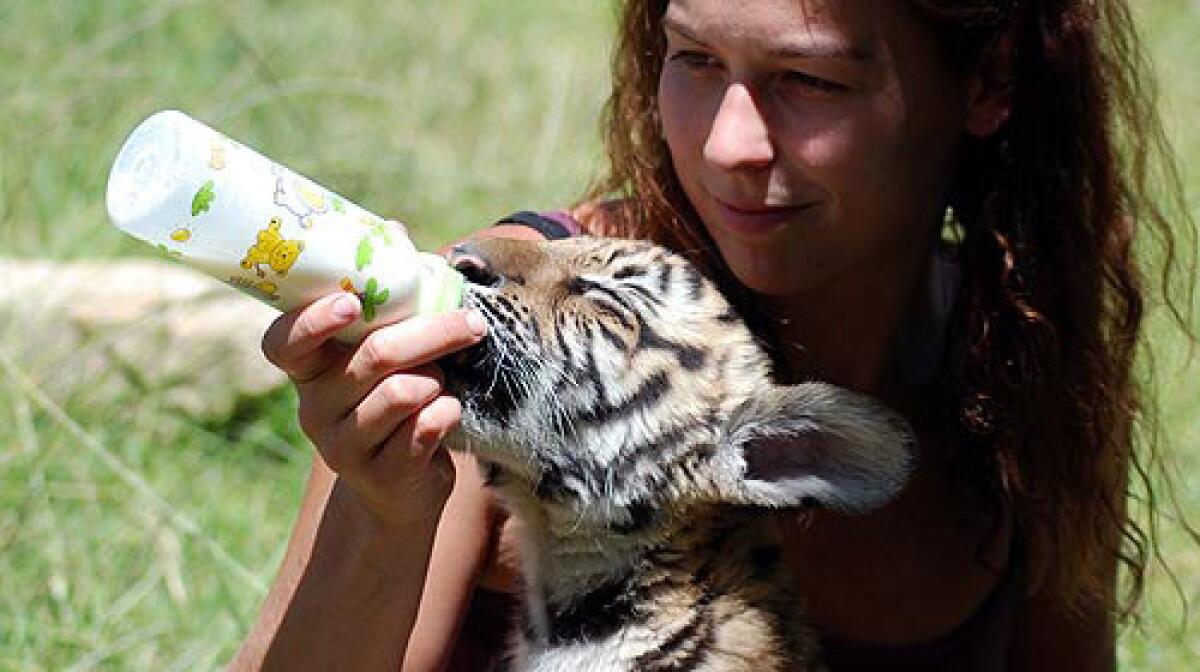Fighting for Chinese tigers, and the last word

- Share via
PHILIPPOLIS, SOUTH AFRICA — He is a magnificent animal, his coat a glossy amber, his fangs long and sharp. He flicks his long tail and paces restlessly up and down beside the bars of the cage. But this tiger, known only as 327, is on the outside and longs to get in.
He is one of the last few surviving South China tigers, born in a Chinese zoo and sent to South Africa last year as part of a last-ditch effort to save a creature that most of the conservation world regards a lost cause.
In this reserve called Laohu Valley, 327 could have the freedom of a 100-acre bush enclosure and learn to hunt, but he can’t shake a lifetime of padding up and down in a concrete cage. The 5-year-old is slowly being weaned from the breeding center, the reserve’s only cage, where he feels safest. He is making progress, slowly. At least he is not afraid of the swaying grasses anymore.
Some would see 327 as proof that trying to save the world’s most endangered tiger and reestablish wild populations is a hopeless cause.
But not Li Quan, a Beijing-born former fashion executive with a dream so large that many tiger conservationists ridicule her. She and her husband, American investment banker Stuart Bray, are trying to drag the species, almost wiped out in a “pest eradication” campaign by the government of Mao Tse-tung, back from the brink of extinction.
Quan’s “rewilding” plan goes like this: China lacks conservation expertise and habitat with adequate prey, so five of the remaining 60 to 70 Chinese zoo tigers have been brought to South Africa, which has both, to breed and to learn to hunt in bush enclosures. The move buys time and builds numbers while the Chinese government restores the habitat for a tiger reserve in China by moving people out and bringing game in.
Conservation groups such as the World Wide Fund for Nature deride the project, saying it is foolish, unscientific and a waste of money.
The most stinging attack came in 2003 from Judy Mills, a tiger conservationist and then-spokeswoman for Conservation International. She called the project “a circus sideshow dressed up as eco-tourism” and said its only outcome would be that “a wealthy dilettante feels as if she has done something. Conservation should be left to conservationists. This woman would be better off giving her money to those who know what to do with it.”
Mills, now with the Save the Tiger Fund, said via e-mail there was “consensus in the mainstream conservation community that the very best course of action for bringing back wild tigers in China is to focus on protecting existing wild tiger populations and their habitats.”
Quan, who initially hoped her plan would win approval in the conservation world, was disheartened and hurt by the attacks. “But then it turned to energy,” she says. “I thought, ‘I’m going to stake everything I have to prove you wrong.’ ”
The five zoo tigers brought to Laohu Valley, in South Africa’s Free State province, included four cubs, Cathay, Hope, TigerWoods and Madonna, who arrived between 2003 and 2007. All learned to hunt wild South African game in the 100-acre enclosure, but two years after arriving in 2003, Hope died of heart failure and pneumonia, confirming in critics’ minds their view that the plan was a bad idea. And 327, who arrived in September mainly for breeding, so far hasn’t mated successfully. (The name comes from his registration number in the “Stud Book” registry of captive tigers.)
The other tigers adapted quickly. They all have their favorite trees and shady places. TigerWoods has a cozy sleeping spot in bulrushes by the river, where small crimson birds flutter just above his head.
In November, a male cub was born at Laohu, the first outside China.
Quan, 45, never planned to run the project herself. But with the tiger conservation world mostly opposed, she has battled to raise funds and find specialists willing to help.
Now she divides her time between her home in London, South Africa, and China. Her team consists of Peter Openshaw, 45, a South African game ranger who left his country’s conservation bureaucracy disillusioned because he felt it was going downhill; Tigris Zhang, 25, a Chinese tiger enthusiast and graduate in urban conservation who started a tiger website in high school; and Zhang’s wife, Jane Shen, 27, a linguist studying tourism.
So far, Quan and Bray have spent $12 million of their own money, including buying 81,000 acres of South African farmland in 2002 for the project, and have raised about $360,000 in donations.
The silvery grass dances on the lush plains of the Karoo, sheep farming country famous for its wide spaces, blue skies and bountiful lamb. There are few trees, just a scattering of steel windmills and rocky hills disturbing the relentless plains.
Behind the wheel of a hefty SUV, Quan touches the accelerator with her delicate lilac loafer. She’s wearing shorts and a sequined cardigan with a kitten design and has features as fine as bone porcelain -- a girlish demeanor that leadssome to underestimate her, overlooking her steely core.
She edges the vehicle over the bank of a river onto a rocky ledge, looking for Cathay and her mate, TigerWoods, parents of the cub. They killed a blesbok -- a small antelope -- the night before, and Cathay is in thick scrubby trees by the river, the tigers’ favorite haunt, finishing off the carcass. She gazes languidly at the vehicle.
“You can see their confidence. Once they have learned to hunt, they can hunt anywhere,” Quan says.
She was born in 1962 in the wake of a three-year famine in China, and grew up during the Cultural Revolution, when the country was poor and intellectuals were humiliated and sent to labor camps for “reeducation.” She befriended every stray cat she could.
After graduating from Beijing University in 1984, she was assigned a prestigious job as an anchor for CCTV but rejected it, knowing she was too outspoken to survive in such a post.
Eventually, she decided to study in America, graduating in business studies at Wharton. She became Gucci’s licensing manager in Milan, Italy, before marrying Bray and giving up her career. She says she always had two passions in her life: tigers and anthropology. She launched her foundation, Save China’s Tigers, after a dinner-party conversation, when a friend complained she was wasting her talent.
But another talent seems to be her ability to set critics’ teeth on edge, from the ease and speed with which she negotiated the tiger deal with the Chinese government (critics said she was being manipulated) to the fact that she was pictured cuddling the newborn cub (they said she set a bad example).
She keeps Persian cats in her London home and says they’ve helped her understand tiger behavior. But she is no softy.
“I don’t cry very easily,” she says. “I cried when Hope died. Emotionally, I was devastated. And I cried when the cub was born, out of happiness.”
The cub, born on a freezing November night at the end of the Southern Hemisphere spring, had to be taken from Cathay not because she rejected him but because she did not lick him dry or warm him.
The cub has spent his first 2 1/2 months in a specialist zoo, where he squalls loudly for attention and leaps playfully on visitors. He will return to the reserve after his final vaccination, when he is 4 months old. A competition to name him has attracted more than 7,000 entries in China alone, a sign of growing awareness of tiger conservation.
One evening, as Quan checks on the tigers, her favorite, Madonna, walks to the fence and chuffs excitedly at her, puffing out air in a tiger greeting. She prowls along the fence as Quan follows on her side.
The next morning after dawn, TigerWoods is lying in the grass when Cathay spots a blesbok. She stiffens and lopes closer. The blesbok easily skirts her, skipping away into the grass toward the hidden TigerWoods, who leaps up in ambush. The terrified blesbok races back toward Cathay, the stronger hunter, who sprints toward it. But the blesbok changes direction and escapes across the river. The tigers follow it for a while before flopping down near the river.
Two days later, they do manage to kill it. That week, in early February, the tigers killed five blesboks released in the enclosure; Cathay’s larger-than-usual appetite and the fact she has not displayed her monthly estrous cycle have Laohu staff convinced she is again pregnant.
Many doubted the tigers would learn the art of hunting in the flat Karoo plains, with limited cover for predators. At first, the young tigers would charge across the open ground, allowing their prey to escape easily. But they quickly learned to stalk and ambush the blesboks.
There were some hard lessons. Hope was bitten by a baboon. Madonna at one point got dehydrated.
“There’s no exact recipe,” Openshaw, the game ranger, says. “They don’t have the mother to teach them to pluck the feathers off a guinea fowl or break open a springbok. They have to learn by trial and error. The first couple of kills have to be quite easy. Then you make the process more difficult.”
As a child, Openshaw spent most of his time in the bush, catching snakes and spiders. Initially skeptical about Quan’s project, he changed his mind on learning the animals would be not be roaming wild and gobbling down South Africa’s own endangered species.
“Even today, when we went into the enclosure and we saw TigerWoods and Cathay, at no stage did they come up and beg for food; it proves that they’re on the right track,” he says.
Quan’s agreement with the Chinese government is to produce two pairs of unrelated tigers to return to a Chinese tiger reserve. But China missed its 2007 deadline to restore reserves with suitable habitat and game: Two sites have been identified in Jiangxi and Hunan provinces, but residents have not yet been moved out of the areas.
“The birth of the cubs will create pressure on the relevant authorities to do something about it,” Quan says.
Openshaw is not convinced the plan will succeed but says his group has to try.
“You just have to persevere and put your head down and keep on going,” he says. “At least we’re doing something. I’d rather say, ‘Well, we didn’t save the animals from extinction, but gee, we gave it our best shot.’ ”
Gary Koehler, wildlife research scientist with the Washington Department of Fish and Wildlife, believes conservationists have been so hostile to the South African experiment because of a reluctance to embrace new and radical ideas.
“I think that us in the conservation profession and even us as scientists are not real comfortable with experiments in a very new and radical way,” he says. “And sometimes that’s what it takes.”
Quan sees Hope, who was the weakest of the reserve’s tigers before he died, as a symbol of the South China tiger’s crisis: “He’s weak. He’s sickened. He needs help. At the end of Hope’s life, he could not even climb over a tree that he always crossed.
“The South China tiger has to jump over a big barrier to be saved,” she says. “They might not jump. Despite all the effort, they might still go extinct. But we must try to help them.”






